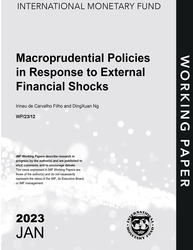
Macroprudential Policies in Response to External Financial Shocks
Macroprudential Policies in Response to External Financial Shocks
READ MORE...
Volume/Issue:
Volume 2023
Issue 012
Publication date: January 2023
ISBN: 9798400230035
$20.00
Add to Cart by clicking price of the language and format you'd like to purchase
Available Languages and Formats
| English |
Prices in red indicate formats that are not yet available but are forthcoming.
Topics covered in this book
This title contains information about the following subjects.
Click on a subject if you would like to see other titles with the same subjects.
Labor , Economics- Macroeconomics , Money and Monetary Policy , Economics / General , Macroprudential policy , external shocks , loan to value , figures entry , map authority , Model simulation , foreign currency , interest rate shock , bank profit , Credit , Real exchange rates , Financial statements , Bank credit , Self-employment , Global
Summary
This paper examines how countries use Macroprudential Policies (MaPs) to respond to external shocks such as US monetary policy surprises or fluctuations in capital flows. Constructing a model of a small open economy with financial frictions and a MaP authority that adjusts loan to value (LTV) ratio limits on borrowers and capital adequacy ratio (CAR) limits on banks, we show that using MaPs where stochastic external financial shocks are present entails a trade-off between macro-financial volatility and GDP growth. The terms of the trade-off are a function of a few country characteristics that amplify financial channels of external monetary shocks. Estimating MaP reaction functions for a panel of 41 countries in the period 2000–2017, we find that countercyclical macroprudential policy in response to surprise US monetary tightening is more likely for countries with net short currency mismatches (that is, foreign currency denominated liabilities larger than foreign currency denominated assets), consistent with the model’s predictions. The paper also finds that domestic credit and interest rates are more insulated from US monetary tightening for countries that employ MaPs countercyclically.
Copyright © 2010 - 2025
Powered by:
AIDC



